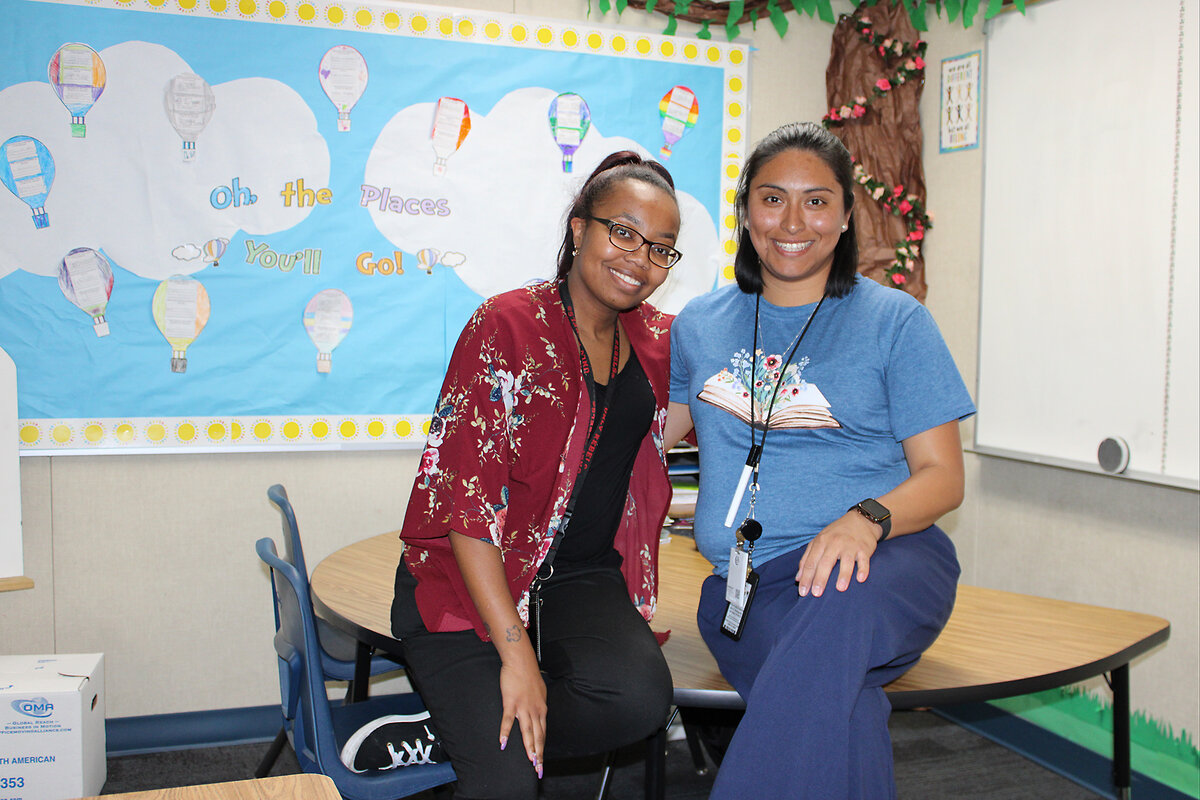Teacher apprentice programs are growing. Nevada offers a model.
Loading...
| Las Vegas
Where’s the best place to look for an aspiring teacher?
These days, school leaders are launching talent searches inside their own buildings. In Nevada, districts are increasingly turning to their support staff members – such as bus drivers, substitute teachers, cafeteria workers – as possible recruits.
That’s how Jeanette Sanjurjo, a long-term sub, found a path back to college to become a full-time classroom teacher. In 2022, she received an email from the Clark County School District in Las Vegas. The message invited her to apply for an apprenticeship program that leads to a virtually no-cost bachelor’s degree.
Why We Wrote This
A story focused onOne obstacle keeping people from careers in teaching is the cost of training. Can a trade school model work for educators?
It offered a way for Ms. Sanjurjo to finish her education degree – a feat she previously considered impossible for financial reasons.
“How do you figure out how to go through your practicum and your student teaching?” she says. “Those are times where you’re expected to be in the classroom with no pay.”
In April, federal, state, and local leaders converged inside Ms. Sanjurjo’s fourth grade classroom at Laura Dearing Elementary School in Las Vegas. They came to tout the apprenticeship program that landed her here. A few years ago, no states offered registered apprenticeships for teachers. Now, 34 states and Puerto Rico offer such programs, according to the U.S. Department of Education.
“Nevada is raising the bar on how you grow and support future teachers,” Education Secretary Miguel Cardona said during his visit with acting Labor Secretary Julie Su. “And it’s a model I’d like to see in workplaces across the country.”
The concept reflects a change in the way the education field recruits and retains its workforce given ongoing struggles. A majority of teachers – 77% – say the job is frequently stressful, and more than half would not advise a young person to enter the profession, according to a recent Pew Research Center report.
At the same time, enrollment in college education programs is dropping. The dampened interest is forcing school districts and higher education institutions alike to rethink how they recruit.
“The way we think about [college] students is changing,” says Danica Hays, dean of the College of Education at the University of Nevada, Las Vegas. “The student is no longer your 18-year-old.”
Instead, they’re people like Ms. Sanjurjo or her colleagues, Christina Romero and Eboniee Rose. All three felt drawn to teaching but, for a variety of reasons, didn’t immediately pursue it.
The Nevada Forward Initiative, housed within the College of Education at UNLV, offered them a way into the profession. It also helps people with degrees in other fields get licensed to teach.
By Nevada law, apprentices operate under a learn-and-earn model, meaning they cannot pay for tuition and fees. State legislation passed in 2021 and 2023 also opened the door for student teachers to work as long-term substitutes without any waiting period.
Under those parameters, aspiring teachers accepted into the apprenticeship program pay no tuition and can earn money while working in schools. The two-year apprenticeship program is followed by an additional two more years of support and professional development.
“It definitely takes the weight off your shoulders,” says Ms. Rose, an apprentice who works as a long-term substitute at Laura Dearing Elementary. She co-teaches a third grade class with Ms. Romero, who is also an apprentice.
That’s exactly how the program authors envisioned it.
“The full concierge approach is about saying, ‘Your job is to be a student, and we have a team that will take care of the rest,’” says Kenny Varner, an associate dean for academic programs and initiatives at UNLV’s College of Education. That includes registration and course scheduling.
The program boasts a nearly 95% graduation rate and currently has 509 registered apprentices across the state, according to data from UNLV. So far it also has a 85% retention rate within the teaching field among the first two cohorts of students who graduated.
Though the bulk of apprentices are in the Las Vegas or Reno areas, 75 live in rural counties, where recruiting is even more challenging.
Dr. Varner says the apprenticeship program stands to create a fully licensed school district staff in tiny Esmeralda County, which counts fewer than 800 residents. “Their solution isn’t to try to recruit people to come up there,” he says. “It’s to say we have this talent here.”
Even amid teacher shortages, it’s not just about plugging classroom vacancies. The program tends to yield licensed teachers who have ties to the neighborhood schools where they work and who look like the children they serve. In other words, it’s boosting teacher diversity and retention efforts, too.
Ms. Rose sees the advantage of relating to her students and modeling what they can achieve later in life.
“I’m like, ‘Hey, everything that you guys are doing right now, I’ve walked these same streets. I know that same Jack in the Box on the corner,’” she says. “For me, I am dedicated to teaching in areas such as these – the lower socioeconomic areas – because this is where I grew up.”
Ms. Romero, who speaks Spanish, finds pride in breaking down language barriers with students and their parents. A parent whose child has since moved to a higher grade still comes to her with questions.
UNLV leaders have started emphasizing these fulfilling aspects of teaching careers as they recruit both adults and high school students. The university is launching a youth apprenticeship program that will give high school students the opportunity to accumulate up to 36 college credit hours and embedded work experiences, usually in the summer, before they graduate.
“We talk about the value of teaching versus the job of teaching,” Dr. Hays, the dean, says.
As for the sustainability of the program, Dr. Hays says she’s optimistic UNLV can continue securing federal, state, and other funding sources. The program was initially funded by federal pandemic aid. Dr. Cardona highlighted $48 million worth of federal investments toward these types of programs during his stop at Laura Dearing Elementary.
For Ms. Sanjurjo, it was an easy decision to join the program, even if it seemed too good to be true. All she needed was a great work ethic, she says, to get her where she is today: leading a class of enthusiastic fourth graders.
“I didn’t even have to think about a job,” she says. “It was there.”







